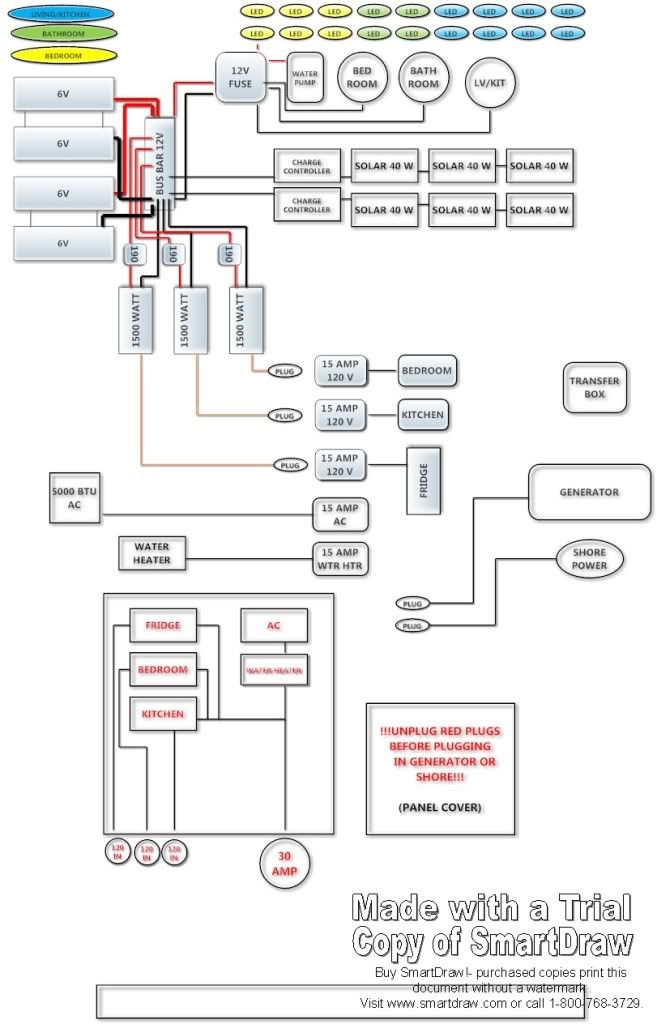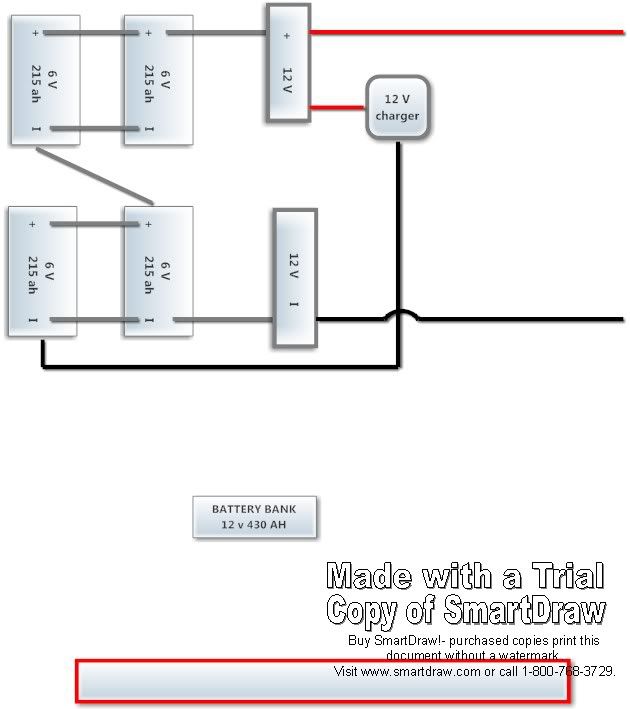I hope this is the right section
I am posting this so I can "see" it from a different light
Biggest goal is to keep the fridge going come hell or high water
The inverters will be plug and plug so if one goes bad it's as simple as unplug and plug into another one
No transfer switch since this is our bus and others will not be using it (we can plug and unplug as we see fit; also it will be built in stages so we can use it as we build)
So going down the road the only inverter on will be for the fridge (the others can be turned on if needed)
When stopped if we choose we can unplug the inverters (to stop back feed and incase accidently turned on)) and plug in either shore or generator power
This will then allow all "inverter breakers" as well as ac and water heater to have power
The plugs mounted on/in the box will be male so that there wont be a live end when connected to power also the plug ins will have flip down doors so prying fingers can't test the breakers
My plan is to have all circuits grounded the way they where if extension cords where used (mmmm that doesn't make since :?)
Generator is not grounded to anything so it’s like using a big extension cord only with circuit breakers
Invertors are not grounded once again like using an extension cord
Circuit breaker box will be isolated from vehicle ground and all outlets will also be isolated from vehicles shell and tied to the box so that all circuits and box are "a unit")
Should the electrical boxes be grounded also like a house with a short wire from receptacle?
The inverters will just tie in the same way inside the box
Will this work?
In theory(mine ) we should be able to test shore pole to insure proper grounding and then we plug in and the shore takes over grounding...is that right?
) we should be able to test shore pole to insure proper grounding and then we plug in and the shore takes over grounding...is that right?
Or will I start popping the camp ground fuse?
Remember this is just the start so any ideas or wisdom will be listened to

I know there is a lot of redundancy built into it, I am using a lot of acquired stuff from other projects and this will be built in stages so we can use the vehicle this summer like a steel tent and add “stuff” as time permits and more creature comforts are needed
I just want to keep the neutrals and grounds separate right to keep from turning the shell into an electricutioners dream ride, I have read so many stories of people leaning against a vehicle and getting shocked
Sorry so long thank you for looking
I am posting this so I can "see" it from a different light
Biggest goal is to keep the fridge going come hell or high water
The inverters will be plug and plug so if one goes bad it's as simple as unplug and plug into another one
No transfer switch since this is our bus and others will not be using it (we can plug and unplug as we see fit; also it will be built in stages so we can use it as we build)
So going down the road the only inverter on will be for the fridge (the others can be turned on if needed)
When stopped if we choose we can unplug the inverters (to stop back feed and incase accidently turned on)) and plug in either shore or generator power
This will then allow all "inverter breakers" as well as ac and water heater to have power
The plugs mounted on/in the box will be male so that there wont be a live end when connected to power also the plug ins will have flip down doors so prying fingers can't test the breakers
My plan is to have all circuits grounded the way they where if extension cords where used (mmmm that doesn't make since :?)
Generator is not grounded to anything so it’s like using a big extension cord only with circuit breakers
Invertors are not grounded once again like using an extension cord
Circuit breaker box will be isolated from vehicle ground and all outlets will also be isolated from vehicles shell and tied to the box so that all circuits and box are "a unit")
Should the electrical boxes be grounded also like a house with a short wire from receptacle?
The inverters will just tie in the same way inside the box
Will this work?
In theory(mine
Or will I start popping the camp ground fuse?
Remember this is just the start so any ideas or wisdom will be listened to

I know there is a lot of redundancy built into it, I am using a lot of acquired stuff from other projects and this will be built in stages so we can use the vehicle this summer like a steel tent and add “stuff” as time permits and more creature comforts are needed
I just want to keep the neutrals and grounds separate right to keep from turning the shell into an electricutioners dream ride, I have read so many stories of people leaning against a vehicle and getting shocked
Sorry so long thank you for looking



